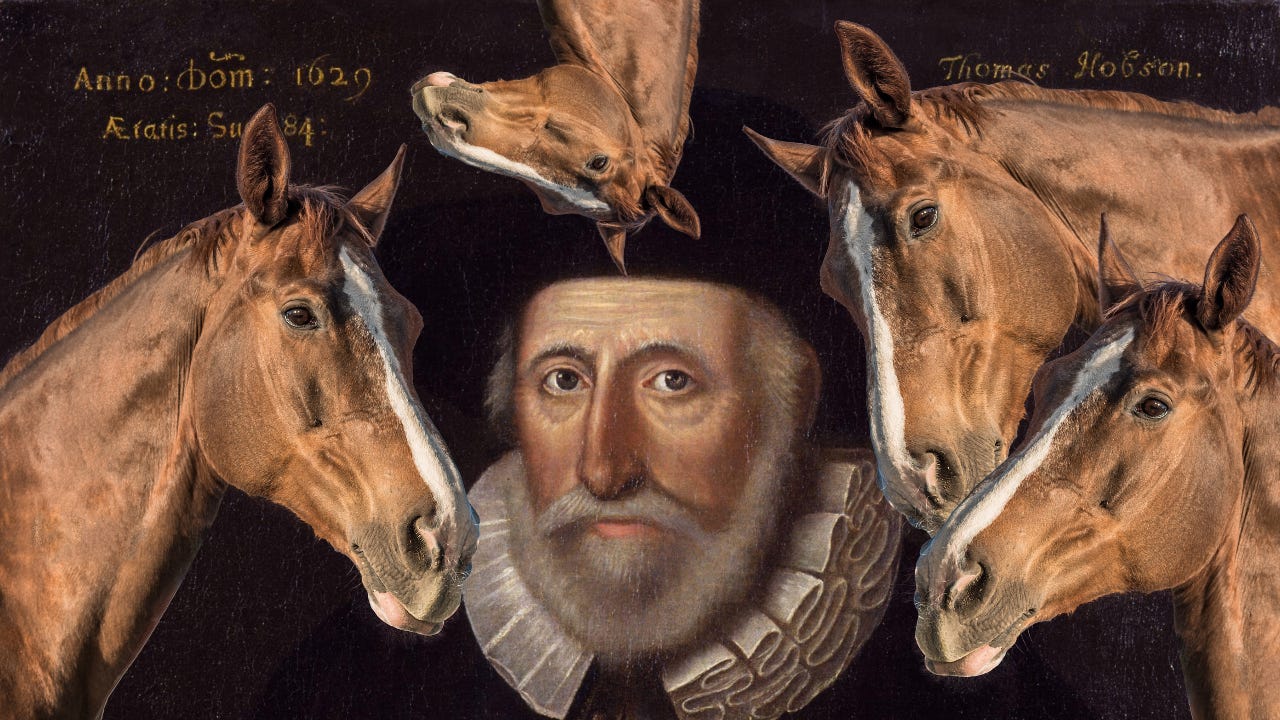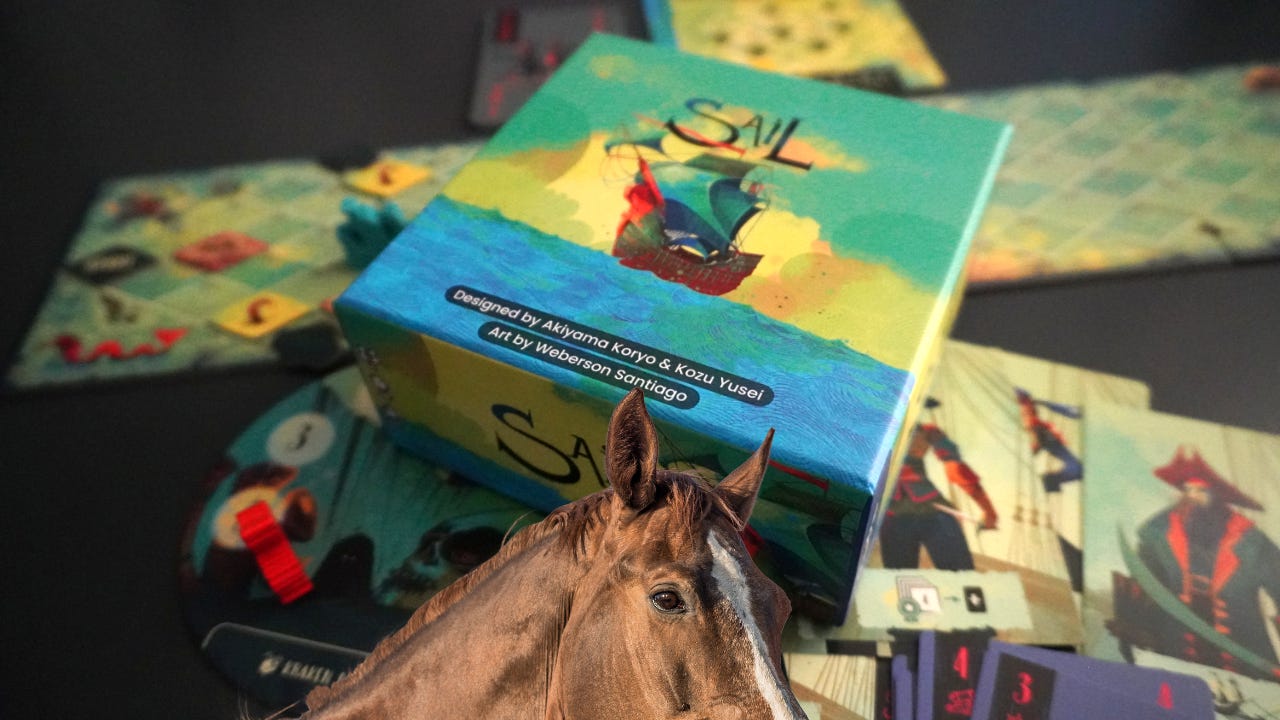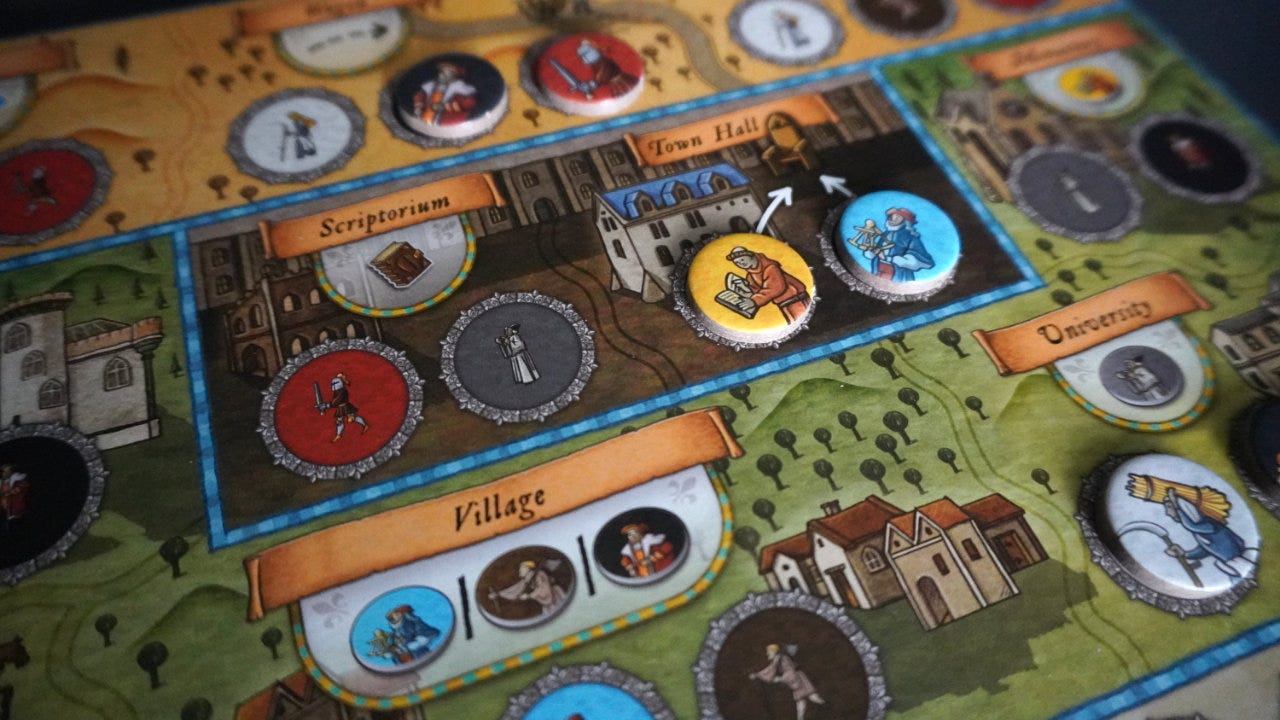I'll give you a choice: take it or leave it.
Exploring the concept of Hobson's Choice in tabletop games, how to identify them, and when they are a good (or bad) part of a game's design.
This is Part 2 of a two-part series on decision spaces in tabletop board games and roleplaying games. Be sure to read Part 1 - What is a game’s decision space?.
The story goes that Thomas Hobson (c. 1544 - 1631) maintained a stable of forty horses which he would rent out for travelling. When a customer would approach, they’d see all the options, but were only allowed to rent the horse closest to the door. While this ensured that all the horses were rented and ridden equally, it also meant that the customer really didn’t have a choice when it came to which horse they wanted.
They could take the horse in the stall near the door or none at all.1
This illusion of choice which is really no choice at all has become known as a Hobson’s choice — take it or leave it.2 This is particularly true when the “leave it” option is particularly undesirable.
A similar example is attributed to Henry Ford when he said, “Any customer can have a car painted any color that he wants so long as it is black.” Again, this would be a Hobson’s choice. Either take a black car or no car at all.3
Understanding how to spot a Hobson’s choice is important in game design because it impacts a game’s decision space. Let’s explore how.
Actual vs. apparent decision spaces
Last week we looked at decision spaces in tabletop games — the measure of all meaningful choices available to a player at a given time. I was careful to include the word “meaningful” in that definition. In this context, a meaningful choice is one that allows for a player to have agency.
The apparent decision space might be limited or smaller than expected for a few different reasons. As Geoff Engelstein mentioned in the comments, it might be limited due to a player’s preferred strategy:
One aspect that also can help control the decision space for players is Strategy. If a player has a strategy - for example, they're trying to build lots of buildings rather than transport goods (to make up a game), they can focus on those actions and abilities that will enable them to pursue that. Or in chess, if you decide you want to put pressure on a certain piece that will help focus what moves you evaluate.
This allows players to 'self-prune' the decision tree to get down to just a handful of good options to decide between.
Using strategy to reduce a decision space is a positive aspect of game design. It allows for a large, wide decision space but helps limit AP by allowing the player to “prune” some of the options. If they are focusing on a specific strategy, some of the options can be eliminated, thereby reducing the apparent decision space to a much smaller actual decision space.
Giving players starting goals and variable player powers can assist players with their first turns. It helps solve the “What do I do?” problem that sometimes shows up at the start of complex games.
Not all decision space limitations, however, are as positive as this.
Hobson’s choices in tabletop games
In the article on player choice, I mentioned three ways in which players can be presented with false choices — the illusion of choice:
The player has no information or knowledge by which to make the decision. All options seem equally good or bad, and a random selection is as good as any.
The choices all lead to the same outcome, regardless of the option selected.
The output randomness built into the system greatly outweighs the impact of any actual player decisions based on available options.4
A fourth way is to give the player a Hobson’s choice — a choice in which either they take one action or no action at all.
It’s not always obvious when this happens and it’s not always a particularly bad thing.
Take this action or no action at all
This can arise in a few different ways:
Trick-taking games: It is common in trick-taking games to have a rule that says you must play a matching suit if you have a card of that suit. If a player has only one card of the matching suit, they must play it. Although they have a hand of cards, their choice is to play that card or don’t play at all.
TTRPG combat encounters: It is possible that in very simple RPG combat encounters, the player is presented with a Hobson’s choice. Attack with your only weapon or don’t attack at all… where not attacking is really not an option. Even adding “fleeing” as an option may not solve this.
Tactical in-game decisions: In some games such as 7 Wonders (Bauza, 2010) and The Lord of the Rings: Duel for Middle-earth (Bauza & Cathala, 2024) it is possible to carefully draft cards in a way to force your opponent to either take a card or no card at all. In this case, it’s an intentional strategy and part of the game. Notably, this isn’t every turn and it only happens once in a while.
Only one sensible strategy: When a player has a hand of cards, it’s possible that in effect it only makes sense to play one of them.5 While they could technically play any of the cards, only one would advance their progression toward winning the game. The other cards would either do nothing or regress their position. Their choice is to play the one card that makes sense or make a clearly bad move.
Recalling workers: Some worker placement games force a player to recall all of their workers after they have been placed. In this case, their option is to recall all of their workers or not play the game.
In the four examples above, not all are equally problematic. In fact, some of the examples are valid game designs that lead to positive player experiences. As with most things, it comes down to the kinds of fun you want your players to have.
Identifying Hobson’s choices
Knowing that not all Hobson’s choices are design flaws, it is still important to be able to identify them in a game’s design. Here are a few ways to do that:
Watch for lightning fast turns: During playtesting, watch for turns where players take their turn seemingly without thinking about it first. They instantly place their worker, play their card, or grab a resource. They say, “I guess I’ll attack.” without much consideration. While this might be just players who plan ahead, it could be a sign that they were presented with a Hobson’s choice.
Ask about alternative actions: When we explored playtesting questions, one of them was, “If you played again, what would you do differently?” While this question is targeted at a macro level of the game’s design, it might prompt the player to point out turns where they felt like they had no real choice.
Watch player’s enthusiasm or anxiety: In a game with a large (perhaps too large) decision space, players might struggle to decide what to do on a turn. Locking in their move and removing their hand from their player token might cause some serious anxiety. If this is completely missing and instead the player simply says, “Well, I guess I’ll do this because it’s all I can do…” it might be an area to explore.
Designing systems with tough decisions, where every choice has significant pros and cons, is a way to avoid inadvertently including Hobson’s choices in a game’s design. Additionally, adding some input-output randomness might help as well.
Conclusion
Some things to think about:
Watch for Hobson’s choices: As a little exercise this week, watch for Hobson’s choices not only in the game you play but in regular life too. Learn how to spot the non-obvious ones where you are given a “take it or leave it” choice.
Not all limited choices are Hobson’s choices: There are many kinds of severely restricted decisions and many of them have specific names such as Morton’s fork. It’s good to learn the subtle differences between each type.
Not all Hobson’s choices are bad: While some “take this action or no action at all” choices can be disappointing in tabletop games, not all of them are. As noted above, the occasional forced choice can be a compelling part of a design — especially when it is forced onto an opponent.
What do you think? Are Hobson’s choices usually a good or bad thing in game design? I’m particularly curious if you have some examples of where they are intentionally used to improve a game.
— E.P. 💀
P.S. Unknown Dungeon’s One-Page RPG Jam 2025 starts soon! Submissions open from July 13th to August 17th. Get a copy of Make Your Own One-Page RPG and make weird games! 🚀
Skeleton Code Machine is a production of Exeunt Press. All previous posts are in the Archive on the web. Subscribe to TUMULUS to get more design inspiration. If you want to see what else is happening at Exeunt Press, check out the Exeunt Omnes newsletter.
There are many versions of this story about Thomas Hobson, but here is one that appeared in The Spectator in 1712: “I say, Mr. Hobson kept a stable of forty good cattle, always ready and fit for travelling; but, when a man came for a horse he was led into the stable, where there was great choice, but he obliged him to take the horse which stood next to the stable-door; so that every customer was alike well served according to his chance, and every horse ridden with the same justice: from whence it became a proverb, when what ought to be your election was forced upon you, to say Hobson's choice.”
Note that if the choice is between two equivalent options (neither more undesirable) that would be called a Morton’s fork rather than a Hobson’s choice — one in which both options lead to the same conclusion. This is also different from a false dichotomy where only two options presented where there are actually three or more actual options.
While most were indeed black, Model T automobiles did come in other colors at times. According to the Ford corporate website: “A common myth is that all model T’s were black. While Henry Ford did say ‘Any customer can have a car painted any color that he wants so long as it’s black,’ the policy was in place solely for efficiency and uniformity. The car was only offered in black from 1914-1925, however before and after that various models of the vehicle could be purchased in a variety of colors including blue, red, grey, and green.”
Mark Bigney at So Very Wrong About Games sometimes refers to this as “roll a six, win a cookie.” Meaning you might as well roll a six-sided die and see if you won because the outcome is ultimately random.
This could also be called an “obvious choice” and perhaps not fully reach to the level of a Hobson’s choice. You might be given options such as “Either take 2 resources or 3 resources.” Well, you’d obviously take 3 resources. There is a choice but it is trivial.







I never knew this was called Hobson's choice, but has always been something I'm wary of in TTRPG's.
If there is always a single "correct" action to take in a circumstance it's something I try to change or fix.
Except for fireball, fireball is always a correct answer LoL
Thanks for the education. I didn't know this "choice" had a name; nor did I know about the naming of Morton's Fork.
Regarding footnote #4... a couple of my friends have expressed exactly that opinion about games here and there. "Tomb" comes to mind as an example; after 4 hours of play, with uncontrollable unknowns and incredible randomness - plus dice rolling! - their opinion was "let's save time next time, each roll a die, and high roll wins."